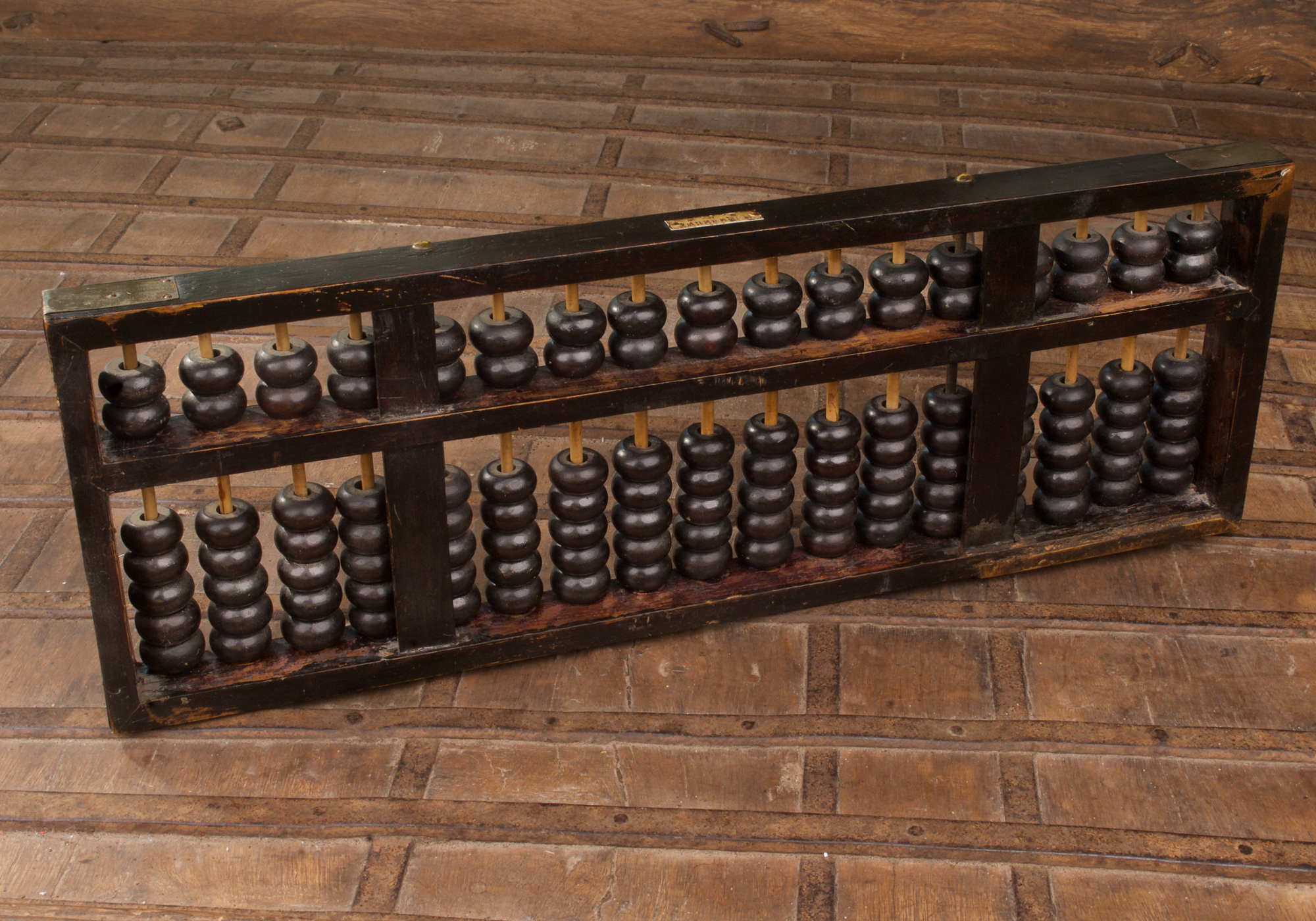- AUST POST SHIPPING
- 0438 654 235
- info@recoverycurios.com
- P.O. Box 7640 Cairns QLD Australia, 4870
-
0
Shopping Cart

VINTAGE CHINESE WOODEN ABACUS
 The suanpan is an abacus of Chinese origin first described in a 190 CE book of the Eastern Han Dynasty, namely Supplementary Notes on the Art of Figures written by Xu Yue. However, the exact design of this suanpan is not known.
The suanpan is an abacus of Chinese origin first described in a 190 CE book of the Eastern Han Dynasty, namely Supplementary Notes on the Art of Figures written by Xu Yue. However, the exact design of this suanpan is not known.
There are two types of beads on the suanpan, those in the lower deck, below the separator beam, and those in the upper deck above it. The ones in the lower deck are sometimes called earth beads or water beads, and carry a value of 1 in their column. The ones in the upper deck are sometimes called heaven beads and carry a value of 5 in their column.
 The similarity between the Roman abacus to the Chinese one suggests that one must have inspired the other, as there is strong evidence of a trade relationship between the Roman Empire and China. However, no direct connection can be demonstrated, and the similarity of the Abacus could be coincidental, both ultimately arising from counting with five fingers per hand.
The similarity between the Roman abacus to the Chinese one suggests that one must have inspired the other, as there is strong evidence of a trade relationship between the Roman Empire and China. However, no direct connection can be demonstrated, and the similarity of the Abacus could be coincidental, both ultimately arising from counting with five fingers per hand.
 Up until 2002 or so, accountants and financial personnel in mainland China had to pass certain graded examinations in bead arithmetic before they were qualified.
Up until 2002 or so, accountants and financial personnel in mainland China had to pass certain graded examinations in bead arithmetic before they were qualified.
 I picked up this gorgeous Chinese Suanpan in an old garage on a country road outside Kuching Borneo.
I picked up this gorgeous Chinese Suanpan in an old garage on a country road outside Kuching Borneo.
It was laying on a pile of old newspapers covered in dust and I asked this wizened old guy in my atrocious Malay if he still used it.
He looked up from his desk with a mouth of stained, broken and missing teeth and laughed.
He then pulled out his iPhone and turned on the calculator!
- LAND
- SEA
- AIR
- VINTAGE ORIGINAL AIRCRAFT INSTRUMENTS
- HAWKER TYPHOON
- VICKERS WELLINGTON
- FAIREY GANNET
- RYAN ST-A SPORTS TRAINER
- DE HAVILLAND TIGER MOTH
- HAWKER HUNTER
- Mc DONNELL DOUGLAS KC-10 AERIAL TANKER
- SOPWITH CAMEL
- AIRCO DH.1 AND DH.2
- JUNKERS JU 87
- CURTISS C-46 COMMANDO
- HANDLEY PAGE HAMPDEN
- SUPERMARINE SEAFIRE
- B-25 MITCHELL BOMBER
- BRISTOL BLENHEIM
- ENGLISH ELECTRIC LIGHTNING
- HAWKER TEMPEST MkVI
- YAKOVELOV YAK - 3
- FOCKE-WULF FW190
- FOLLAND GNAT
- AIRSPEED OXFORD
- SHORT STIRLING
- AVRO ANSON
- DOUGLAS C-133 CARGOMASTER
- HANDLEY PAGE VICTOR BOMBER
- DE HAVILLAND SEA VENOM
- VICKERS VALIANT BOMBER
- DOUGLAS A-26 INVADER
- GRUMMAN S2F TRACKER
- SUPERMARINE SPITFIRE
- LOCKHEED P2-V NEPTUNE
- P-51 MUSTANG
- BRISTOL BEAUFIGHTER
- DE HAVILLAND MOSQUITO
- B-26 MARTIN MARAUDER
- P3 ORION
- DOUGLAS A-20 HAVOC
- P-39 AIRACOBRA
- AVRO SHACKLETON
- B-17 FLYING FORTRESS
- B-24 LIBERATOR
- MESSERSCHMITT BF-110
- MESSERSCHMITT BF-109
- BRISTOL BEAUFORT
- KAWASAKI Ki-45 (NICK) INTERCEPTOR
- C-130 HERCULES
- CAC BOOMERANG
- AVRO LANCASTER
- GRUMMAN F4F WILDCAT
- F4U VOUGHT CORSAIR
- WESTLAND LYSANDER
- P-47 REPUBLIC THUNDERBOLT
- NORTH AMERICAN T-6 TEXAN - HAVARD
- C-47 SKYTRAIN
- DOUGLAS SBD DAUNTLESS
- CAC WIRRAWAY
- PBY CATALINA
- P-40 WARHAWK
- FAIREY SWORDFISH
- P-38 LIGHTNING
- HAWKER HURRICANE
- CURTISS SB2C HELLDIVER
- GRUMMAN F6F HELLCAT
- SEAKING HELICOPTER
- SEAHAWK HELICOPTER
- DOUGLAS A4G SKYHAWK
- GRUMMAN TBF AVENGER
- HANDLEY PAGE HALIFAX
- DOUGLAS SKYRAIDER AE-1
- GLOSTER METEOR
- JUNKERS JU-88
- F-86 SABRE JET
- SHORT SUNDERLAND
- B-29 SUPER FORTRESS
- F-9F GRUMMAN PANTHER
- F-100D SUPER SABRE
- BELL UH-1 HUEY HELICOPTER
- AVRO VULCAN STRATEGIC BOMBER
- CANBERRA BOMBER
- DHC-4 CARIBOU
- BLACKBURN BUCCANEER
- DE HAVILLAND VAMPIRE JET
- HAWKER SEA FURY
- LOCKHEED HUDSON
- LOCKHEED EC-121 WARNING STAR
- SEPECAT JAGUAR
- HAWKER SIDDELEY NIMROD
- HAWKER SIDDELEY HARRIER
- ARADO AR 196
- VOUGHT OS2U KINGFISHER
- LOCKHEED ELECTRA
- NORTHROP P-61 BLACK WIDOW
- BOEING CH-47 CHINOOK
- LOCKHEED PV-1 VENTURA
- BOEING P26-A 'PEASHOOTER'
- Ilyushin Il-2 ‘Sturmovik’
- WESTLAND WESSEX
- FAIREY FIREFLY
- VINTAGE AVIATION COLLECTABLES
- VINTAGE COLLECTABLE MODEL AIRCRAFT KITS
- RETRO STYLE METAL AIRCRAFT COLLECTABLES
- VINTAGE ORIGINAL AIRCRAFT INSTRUMENTS

